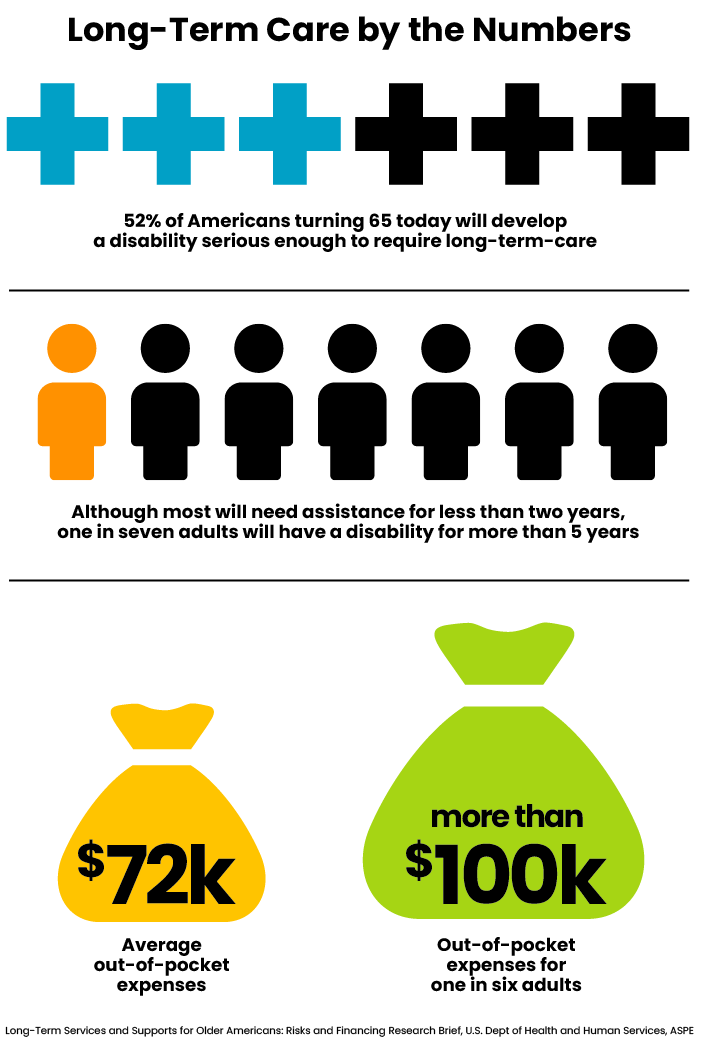
Most advisors know that planning for a client’s long-term care needs is complicated. Because illness and disability can occur without warning, clients often need to make decisions about care quickly and under duress.
To make matters worse, the long-term care system in the U.S. is both fragmented and very costly. In some cases, clients will consult with various professionals to help them determine the best plan of care for themselves or a loved one. However, not many people think to consult with a financial advisor. This is a medical situation after all, so why should they?
Since the need for long-term care is seen by many as a health issue, people seek the advice of health professionals to decide on the appropriate options. Likewise, when it comes to retirement, people discuss their long-term financial needs with a financial professional.
But what happens when a person’s retirement plan is interrupted by a health issue requiring long-term care? The important role of the financial advisor is often overlooked as a key resource when making important decisions about care. Unfortunately, this can lead to choices being made that negatively impact a client’s long-term financial goals.
The Health-Wealth Disconnect
As a gerontologist, I see this disconnect all too often. A few years ago, I met with a couple, Susan, 75, and Joe, 82, (names changed for privacy purposes) to talk about Joe’s need for long-term care. They were referred to me because Joe had been diagnosed with Parkinson’s Disease two years earlier.
Susan had been caring for him at home, but it had recently become quite difficult. She was no longer able to provide the care he needed by herself. Prior to Joe’s diagnosis, Susan had been in good health, led an active lifestyle, and was involved in various activities. Recently, Susan and Joe’s adult children had noticed that Susan’s energy level and overall health were beginning to decline. She spent all day, every day, caring for Joe and was no longer able get out to exercise or meet with friends.
Their children knew it was time for Joe to move to a nursing home. They convinced Susan to begin the process of finding a long-term care facility and she reluctantly agreed.
In our initial meeting, we discussed the types of care Joe would require, and the desired amenities Susan hoped the facility would be able to provide him. We looked at places close to their home so that she would be able visit Joe often. We narrowed down the options and selected a nearby community that met most of their needs. We contacted the facility and luckily, they had a private room available.
Joe could move in as soon as possible. It seemed like everything was falling nicely into place.
The room and board at the skilled-nursing facility Susan and Joe chose was $9,500 per month. Fortunately for them, they had substantial retirement savings, so cost was not necessarily an issue to get him moved in.
“She looked at me rather surprised and said, ‘No, we never thought to do that. Honestly, we didn’t think his health had anything to do with the conversation about our portfolio.’”
Susan and Joe had worked with a financial advisor for years and I knew they met with her regularly. I asked Susan if they had spoken with her at their last meeting about Joe’s health and the possibility that he might need long-term care. She looked at me rather surprised and said, “No, we never thought to do that. Honestly, we didn’t think his health had anything to do with the conversation about our portfolio.”
At that time, Joe was doing fairly well and they both thought Susan would be able to provide the care that Joe needed for the duration of his illness. Susan admitted that up until now they never thought about the potential costs of professional care and how that might impact their retirement savings.
In essence, Susan and Joe, like many people, did not make a connection between their health and their wealth. To be fair, they are not alone. When faced with similar situations, clients most often think of healthcare needs first, and how to pay for it, second.
To make matters worse, time is usually of the essence as many family members try to provide care for their loved ones themselves for as long as possible. Coming to the realization that a loved one needs more care than the family can provide is difficult — which lends to the eventual sense of urgency.
Unfortunately, if advisors are not made aware of a client’s need for transition to long-term care soon enough, they find themselves in the difficult position of having to address the immediate need to raise cash to pay for the high cost of care, while at the same time trying to minimize tax implications to the client.
Additionally, as in Susan and Joe’s case, there may also be the competing need to preserve as much of the assets as possible for the lifetime a healthier or younger spouse.
Sadly, stories like Susan and Joe’s are not that uncommon.
I have found that one of the reasons people do not consult with their financial advisors sooner when making decisions around long-term care needs may be the lack of understanding about the types of benefits that actually cover the costs of care.
Common Misperceptions
For instance, there is a common misperception that Medicare will pay for nursing home expenses. Under certain circumstances, Medicare does cover the cost of skilled-nursing care. However, this is usually only for a short-term period for rehabilitative purposes. Medicare does not cover the costs of a permanent move into an assisted living or nursing home facility.
Furthermore, some believe they can give all their money away to their children and Medicaid will pay for nursing home care. Unfortunately, the process of qualifying for Medicaid benefits is complicated. The income and asset threshold is often so low that a client must essentially become impoverished to qualify for Medicaid benefits.
In addition, the transfer of assets, or “spend down,” to attain Medicaid eligibility is highly scrutinized by authorities and, in many cases, includes a “look back period” of several years. Therefore, the ability to qualify for Medicaid can be difficult for many to accomplish properly and in time to actually meet the need.
For some, a long-term care insurance policy can be a valuable planning tool to help cover the costs of long-term care. However, according to the American Association for Long-Term Care Insurance, only an estimated 7.2 million people in the U.S. own a long-term care insurance policy.
For those clients who do own a policy, it may still only cover just a portion of the total cost of care. While any amount helps, clients must pay the remaining costs which, in some cases, is a still sizeable amount that can greatly impact savings.
In the absence of a long-term care insurance policy or qualifying for Medicaid, paying for the cost of long-term care services is borne by the client.

According to a research brief from the U.S. Department of Health and Human Services, by the time a person reaches 65, they have a little more than a 50-50 chance of needing long-term care. In addition, clients will spend, on average, more than $72,000 out-of-pocket on long-term services and supports. Without proper financial planning, this can have a detrimental effect on a client’s retirement plan.
Start Candid Conversations
Given the complexity and potential pitfalls in planning for long-term care, financial advisors are a pivotal part of the care-planning team. While there is a natural inclination to avoid what to many can be an unpleasant topic, it is important for advisors to be proactive in starting the conversation with clients about their long-term care planning.
Along with understanding the financial implications, helping clients understand that arranging for formal long-term care is often unavoidable. Long-term care plays a vital role in our lives as we age. It often allows us the opportunity to live longer and more safely. It also relieves undue stress and strain on our family members who are trying to provide care for which they are not trained.
Living longer has certainly added complexity to developing a successful retirement plan. Future long-term care needs cannot always be mapped out perfectly. However, the sooner you begin to have candid conversations with your clients about their wishes or need for care in later life, the better. Over time, clients will begin to see you as a valued resource when the time comes to make decisions on addressing their long-term care needs.
Molly Prues, Gerontologist, is CEO and Founder of VistaLynk, a company that provides education on the issues that impact older age and caregiving clients. VistaLynk’s ground-breaking programs provide the building blocks to reimagine aging and empower caregiving.







